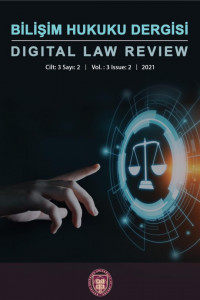Araştırma Makaleleri
Sayı Editör Kurulu



 0000-0002-4144-0649
0000-0002-4144-0649
Amaç ve Kapsam
ASBÜ Bilişim Hukuku Dergisi (ASBÜ BHD), bilişim hukuku alanı ile ilgili hazırlanan özgün ve bilimsel çalışmaların yılda iki kez Haziran ve Aralık aylarında yayımlanması suretiyle literatüre katkı sağlama amacındadır. Bilgi ve İletişim Teknolojilerinin hukuki düzenlemelere konu edilmesinden kaynaklanan meselelerin tartışıldığı akademik bir yayın ortamı oluşturulması hedeflenmektedir.
ASBÜ Bilişim Hukuku Dergisi'nde, bilişim hukuku alanında akademisyen, araştırmacı ve uygulamacılar tarafından Türkçe ve diğer yabancı dillerde hazırlanan makale, karar incelemesi, çeviri, kitap incelemesi gibi bilimsel çalışmalara yer verilmektedir.
ASBÜ BHD'de yayımlanacak makaleler, çift kör hakemlik esasına göre hakem incelemesinden geçirilmektedir.
Yazım Kuralları
YAZIM KURALLARI
Başlangıç
1. Makale başlığı: Amerigo Md BT, 15 pt., Tüm harfler büyük, Kalın, Ortalanmış.
2. Yazar adı: Amerigo Md BT, 13 pt., Kalın, Sağa yaslı, İlk harfler büyük, yıldız ile dipnotta yazarın mesleği,
3. Öz, Abstract ve Anahtar Kelimeler: Kalın, İlk harfler büyük
Metin
1. Metin içi başlıklar: Amerigo Md BT, 12 pt.
2. Başlık başındaki işaretler için yeni liste stili tanımlanması (Word’de Giriş sekmesinde paragraf kutucuğunun içinde üst sıradaki liste işareti/numaralandırma işaretlerinden çok düzeyli liste başlığı altında yeni liste stili tanımla daha sonra sol alttan biçimden numaralandırma seçeneği seçilecek) sıralaması:
1. Seviye: Numaralandırma stili: I, II, III… Kalın, Tümü büyük harfler
2. Seviye: Numaralandırma stili: A, B, C… Kalın, İlk harfler büyük
3. Seviye: Numaralandırma stili: 1, 2, 3... Kalın, İlk harfler büyük
4. Seviye: Numaralandırma stili: a, b, c… Kalın, İlk harfler büyük
5. Seviye: Numaralandırma stili: i, ii, iii... Normal, İlk harfler büyük, İtalik
3. Ana metin: Palatino Linotype, 11 pt.
4. Metin paragrafları: İlk satır 0,75 cm içeride, her iki tarafa yaslanmış, sağ ve sol girinti 0, paragraf öncesi 5nk paragraf sonrası 0 nk aralık, satır aralığı 1.
Dipnotlar
1. Dipnot: Palatino Linotype, 9 pt.
2. Dipnot paragrafları: Asılı 0,5 cm içeride, her iki tarafa yaslanmış, sağ ve sol girinti 0, paragraf öncesi 2 nk paragraf sonrası 0 nk aralık, Aynı stildeki paragraflar arasına boşluk ekleme seçeneği seçilmemiş, satır aralığı 1. Ancak aynı dipnotta birden çok paragraf verilecekse bu durumda söz konusu iki paragraf arasında aralık 0 olmalıdır (üstteki paragrafın paragraf ayarlarından “sonra” kısmı 0 nk, alttaki paragrafın ise “önce” kısmı 0 nk yapılmalıdır).
3. Dipnottaki cümle ile dipnotta sol baştaki numara arasında 1 boşluk bırakılmalıdır.
4. Dipnotta sonu nokta ile biten bir ifade varsa tekrar nokta konulmasına gerek yoktur, bunun haricinde herhangi bir işaretten sonra mutlaka nokta konulmalıdır.
5. Metin içerisinde gösterilen dipnot numaraları şayet bir noktalama işareti varsa onun hemen ardından boşluk bırakılmaksızın belirtilecektir.
Ø Yanlış: verilecektir1. Doğru: verilecektir.1
Kaynakça
1. Kaynakça ayrı sayfada başlayacaktır.
2. Alfabetik sıralı, Palatino Linotype, 11 pt.
3. Kaynakça paragrafları: 0,75 cm asılı (ilk satırdan sonraki satırlar 0,75 cm içeride), her iki tarafa yaslanmış, sağ ve sol girinti 0, paragraf öncesi aralık 3 nk paragraf sonrası aralık 0 nk, Aynı stildeki paragraflar arasına boşluk ekleme seçeneği seçilmemiş, satır aralığı 1.
Aşağıda yazım şekline ilişkin kurallara uygun olarak hazırlanmış örnek word formu bulunmaktadır. Makalenizi bu belgeye aktararak şekil gerekliliklerini kolaylıkla tamamlayabilirsiniz. Form için bkz.
http://dergipark.org.tr/download/journal-file/14917
Yazım-İmla Kuralları ve Atıf Usulü
1. Derginin yazım ve imla kurallarında Türk Dil Kurumunun yayınları ve kararları esas alınmaktadır.
2. Dipnot ve kaynakçalarda "The Chicago Manual of Style" atıf sistemi benimsenmiştir. Atıf sistemine ilişkin detaylı bilgi için bkz.
https://www.chicagomanualofstyle.org/book/ed17/frontmatter/toc.html
3. Eserin yayın dilinin Türkçe olması halinde atıf yapılırken;
§ “and” yerine “ve”
§ “unpublished” yerine “yayımlanmamış” veya "yayınlanmamış"
§ “Anonymous” yerine “Anonim”
§ birden fazla ciltten oluşan eserlerde “volume/vol.” yerine “Cilt.”
§ “see” yerine “bkz.”
§ “in” yerine “iç.”
§ “accessed” yerine “erişim tarihi”
§ “trans.” yerine “çev.”
§ “edited by” yerine “editör”
§ “translated by” yerine “çeviren”
§ “interview by” ifadesi yerine “röportajı yapan”
§ “PhD diss.” yerine “doktora tezi”
§ “thesis” yerine “tez”
§ “last modified” yerine “son değiştirilme”
§ “filmed” yerine “çekim” ifadeleri kullanılmalıdır.
§ Tarih belirtirken kullanılan ay isimleri Türkçeleştirilmiştir ancak yazım formatı korunmuştur. Örneğin; Mayıs 8, 2019 şeklinde yazılmalıdır.
§ Dergi sayısını ifade eden “no.” ifadesi korunmuştur. Keza “ed.” ifadesi aynen korunmuştur.
§ Sayfa numarasında “vd.” kullanılmamalıdır. Bunun yerine ilgili numara ile arasına boşluk konulmaksızın “ff.” İfadesi konulmalıdır. Eğer “ff.”dan sonra “.” gelecekse kullanılmaz ancak “;”, “?” vb. gelecekse onlar “ff.”deki noktaya bitişik yazılır.
4. Metin içerisinde dipnotta gösterilen mevzuat veya mahkeme kararı kaynakçada gösterilmeyecektir. Yargı kararlarına yapılan atıflarda aşağıdaki kural ve kısaltmalar dikkate alınmalıdır:
§ Mahkemenin/kurumun adı varsa dairesi, E. esas numarası K. karar numarası tarih[gün.ay.yıl formatında], (kararın ulaşıldığı kaynak, varsa ulaşıldığı kaynaktaki sayfa numarası veya URL veya DOI numarası).
§ Yabancı kararlarda ilgili mahkemenin veya kurumun kendisinin benimsemiş olduğu karar atıf usulü kullanılabilir. Eğer tercih edilirse Türk kararları için kullanılan sistem de uygun düştüğü ölçüde uygulanabilir. Ancak, bir eserde aynı mahkemenin veya kurumun bir kararı için hangi sistematik kullanılmışsa diğer kararlarında aynı sistematiğin kullanılması gerekir.
|
Anayasa Mahkemesi |
AYM |
|
Bireysel Başvuru |
BB |
|
Bölge Adliye Mahkemesi |
BAM |
|
Ceza Dairesi |
CD |
|
Ceza Genel Kurulu |
CGK |
|
Daire |
D |
|
Danıştay |
Dan. |
|
Esas |
E. |
|
Hukuk Bölümü |
HukukB |
|
Hukuk Dairesi |
HD |
|
Hukuk Genel Kurulu |
HGK |
|
İçtihadı Birleştirme Kurulu |
İBK |
|
İçtihatları Birleştirme Büyük Genel Kurulu |
İBK |
|
İdari Dava Daireleri Kurulu Kararı |
İDDK |
|
Karar |
K. |
|
Uyuşmazlık Mahkemesi |
UM |
|
Vergi Dava Daireleri Kurulu Kararı |
VDDK |
|
Yargıtay |
Yar. |
Örnekler:
AYM, E.2017/172, K.2018/32, 28.03.2018.
Yar. 1. HD, E.2015/1456, K.2017/7086, 05.12.2017, (Kazancı İçtihat ve Bilgi Bankası).
Ankara BAM 2. HD, E.2016/113, K.2017/21, 23.01.2017, (https://legalbank.net/belge/ankara-bolge-adliye-mahkemesi-2-hd-e-2016-113-k-2017-21-t-23-01-2017-bosanmadan-kaynaklanan-tazminat/3040600).
Rekabet Kurulu, K.19-12/136-60, 13.3.2019, (https://www.rekabet.gov.tr/Karar?kararId=c4268558-edce-48b5-996d-152defb6a7e4).
5. Resmi Gazeteye yapılacak atıflar şu şekilde belirtilmelidir: RG. 02.01.2019, S. 30643.
Etik İlkeler ve Yayın Politikası
Ücret Politikası
Dergide makale yayını ve makale süreçlerinin yürütülmesi ücrete tabi değildir. Dergiye gönderilen ya da yayın için kabul edilen makaleler için işlemleme ücreti ya da gönderim ücreti alınmaz.
Bilişim Hukuku Dergisi Creative Commons Atıf-GayriTicari 4.0 Uluslararası Lisansı ile lisanslanmıştır.

